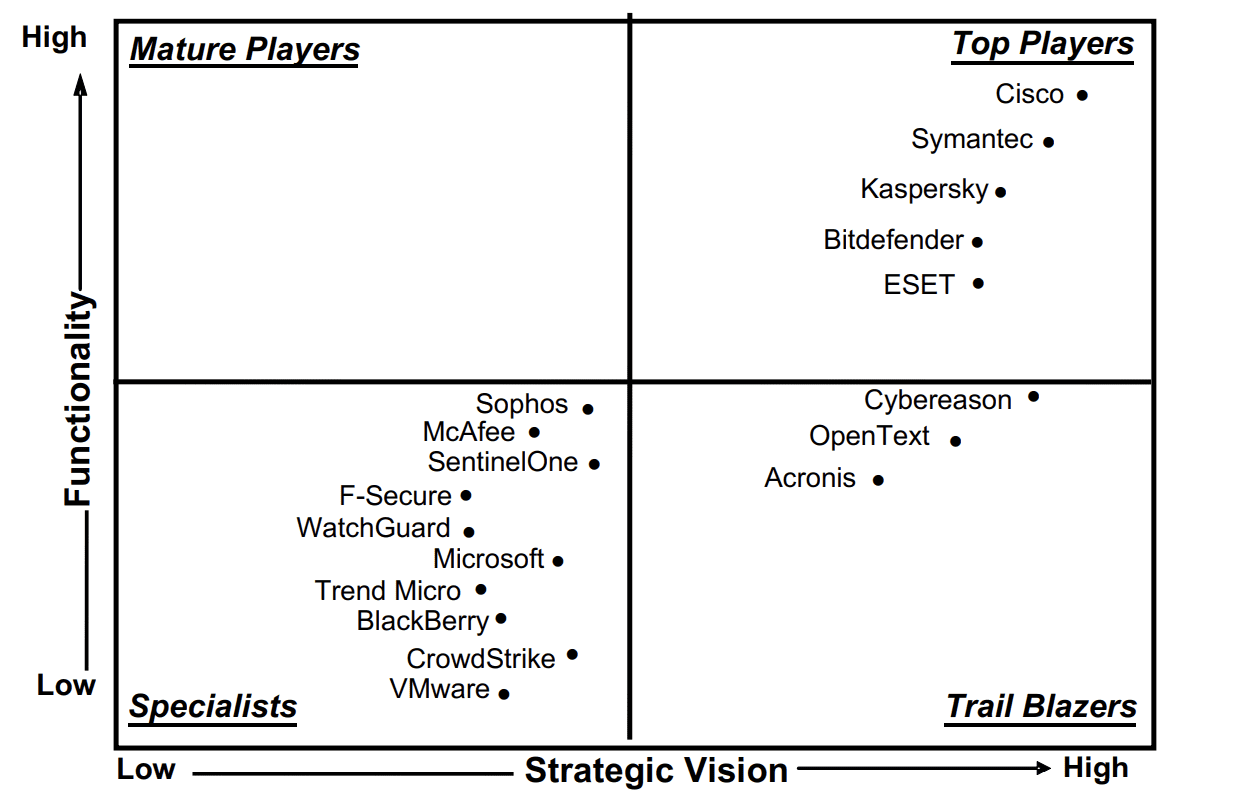Endpoint security comprises appliances, software, cloud services, and hybrid solutions that secure and manage endpoints for business organizations by preventing, detecting, blocking, and remediating all threats to the endpoint.
Endpoint security market forecast
Endpoint protection has become an integral part of an organization-wide defense posture. More organizations are deploying increasingly sophisticated and feature-rich endpoint security solutions for protection from threats and malicious attacks. As a result, the endpoint security market is expected to experience very strong growth to surpass $9.4 billion in 2021 and grow to over $19.8 billion by 2025. The projected revenue growth from 2021 to 2025 is indicated in the below figure.

Leading endpoint security vendors
Leading endpoint security vendors as per the Radicati Group are Acronis, Bitdefender, BlackBerry, Cisco, CrowdStrike, Cybereason, ESET, F-Secure, Kaspersky, McAfee, Microsoft, OpenText, SentinelOne, Sophos, Symantec, Trend Micro, VMware, and WatchGuard.

CISCO: Cisco Secure Endpoint offers Endpoint Protection and Endpoint Detection and Response (EDR) capabilities in a single agent. The Cisco SecureX platform which is built-in to Cisco Secure Endpoint provides threat response with automatic threat context enrichment and unified threat response capabilities across the Cisco Secure Ecosystem comprising endpoints, network, email, DNS, and more.
Symantec: Symantec offers endpoint protection for Windows, macOS, Linux, iOS, Android, Embedded and Virtual machines, as well as a single integrated agent using a single management console for seamless management and performance. Symantec endpoint security with built-in EDR capabilities offers multi-layered protection powered by artificial intelligence and advanced machine learning.
Kaspersky: Kaspersky Optimum Security, which is a cloud-native solution with an on-premise option, integrates endpoint protection, (EDR) and Managed Detection and Response (MDR) into a single multi-layered security approach. The Kaspersky Security Center console delivers security management and control through a single administrative tool and allows organizations to identify all endpoint assets, conduct fast vulnerability assessments, achieve a real-time hardware and software inventory, and offer actionable reporting.
Bitdefender: Bitdefender uses various non-signature-based techniques like heuristics, machine learning models, anti-exploit, cloud-based sandbox analyzer, and process inspector to ensure protection from the latest threats. Bitdefender’s GravityZone Ultra Suite can be easily deployed by all organizations to cover risk analytics, hardening, prevention, and Extended detection and response (XDR) for endpoints, cloud resources, and network-connected devices.
ESET: ESET Endpoint Security solutions offer high performance and high detection rates. Its management console, ESET PROTECT, offers real-time visibility for on-premise and off-premise endpoints. Full reporting for ESET enterprise-grade solutions can also be viewed on a single pane of glass.
Cybereason: The Cybereason Defense Platform uses AI-powered EDR and XDR, intelligence-based behavioral next-generation antivirus (NGAV) prevention, anti-ransomware prevention and proactive threat hunting. It delivers a context-rich analysis of every element of a malicious operation (MalOp) and supports multiple deployment options, including cloud, on-premises, hybrid, and air-gapped.
OpenText: OpenText Security solutions, backed by forensic-grade technology, address enterprise risk, information security and digital investigation needs. OpenText acquired Webroot offers Webroot Business Endpoint Protection and delivers built-in automatic rollback and auto-remediation of infected endpoints. Management is fully cloud-based and is compatible with any browser.
Acronis: Acronis’ endpoint security offerings include Acronis Cyber Protect, Acronis Detection and Response, and Acronis DeviceLock DLP. Its security solutions tightly integrate backup, disaster recovery (DR), anti-malware, anti-ransomware, patch management, detection and response, vulnerability assessments, email protection, URL filtering, and DLP into a single product.
Sophos: Sophos’ endpoint protection solutions include Intercept X Advanced, Intercept X Advanced with XDR, Intercept X with MTR Standard, and Intercept X with MTR Advanced. The XDR version offers traditional and modern protection of Intercept X Advanced, along with XDR functionality across endpoint, server, network, email, cloud and mobile data. In addition to the features in Intercept X Advanced with XDR, the Managed Threat Response (MTR) Service adds a 24/7 managed detection and response service.
McAfee: McAfee Endpoint Security is McAfee’s endpoint protection platform (EPP) that leverages machine learning analysis, dynamic application containment, analytics for file-less attacks, and works with local and global threat intelligence for providing comprehensive insights across file, web, message, and network. McAfee’s MVISION portfolio offers cloud-based MVISION EDR providing automated, AI-guided investigations for security practitioners and works with McAfee Endpoint Security, as well as with third-party EPPs.
SentinelOne: SentinelOne offers a fully converged EPP and EDR platform in a single agent that can run on its own or complement existing AV solutions from other vendors. Its autonomous endpoint agent provides prevention, detection, and response without relying on cloud systems or look up, hence faster detection and response to advanced attacks can be achieved at machine speed.
F-Secure: F-Secure’s cloud-native endpoint protection solutions include EDR, cloud protection for Microsoft 365 and vulnerability management with a single agent and cloud-based management, or as a managed service. It implements a multi-layered architecture for malware detection and endpoint protection.
WatchGuard: WatchGuard offers the cloud-native Unified Security Platform (USP) which is a scalable platform for modern security delivery. WatchGuard Endpoint Security services include advanced endpoint protection complemented by endpoint detection and response (EDR), and specialized security services.
Microsoft: Microsoft Defender For Endpoint is a cloud-based endpoint security solution that comprises risk-based vulnerability assessment and management, EDR, attack surface reduction, behavior-based next-generation protection, managed hunting, automatic investigation and remediation, and unified security management.
Trend Micro: Trend Micro Smart Protection Suites integrates endpoint security, server security, email security, and web security. Its XGen Endpoint Security, makes use of machine learning and other techniques, to protect against ransomware and advanced attacks.
Blackberry: BlackBerry leverages artificial intelligence and machine learning to deliver technology and services offering protection against advanced threats. It provides pre-execution threat prevention and automated detection and remediation against cyberattacks.
CrowdStrike: CrowdStrike Falcon Endpoint Protection is a cloud-based endpoint protection solution offering a combination of next-generation antivirus, EDR, managed threat hunting, IT hygiene, and threat intelligence through a single agent. It uses artificial intelligence and machine learning techniques to offer protection from known and unknown threats.
VMware: VMware Carbon Black provides next-generation Endpoint and Workload Security. The big data and analytics cloud platform, VMware Carbon Black Cloud, helps identify risk, protect, detect and respond against advanced cyber threats, including malware, ransomware, and non-malware attacks.
Visit Endpoint Security – Market Quadrant 2021 by The Radicati Group to get more info regarding the above discussed endpoint security vendors.
Read next: How can I&O leaders leverage the benefits of the cloud model to transform IT operations?








